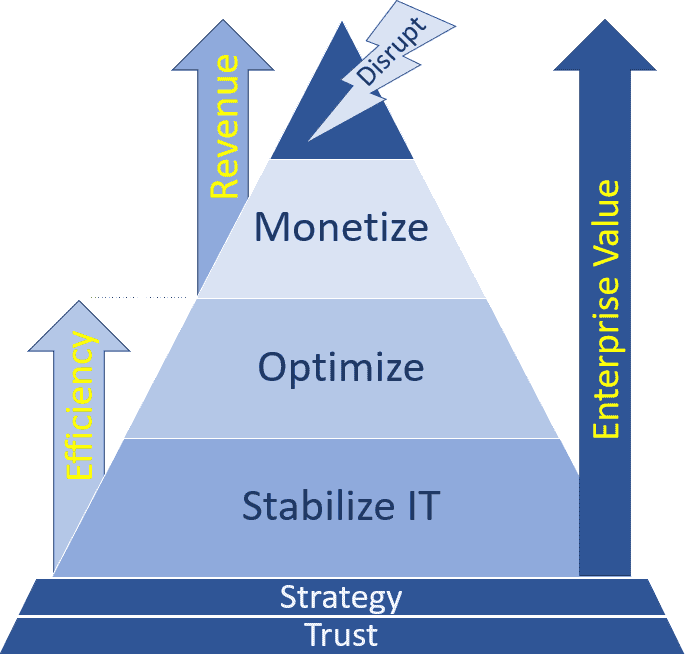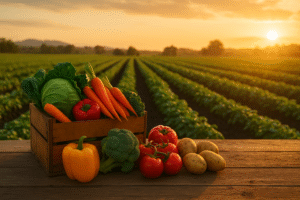Food Service IT & AI Consulting
Proven IT Leaders with Track Records in the Agriculture & Food Service Industries
Food Service IT Experts
From farms and fisheries to restaurants and grocery chains, the food service industry operates on thin margins and high expectations. Success depends on speed, safety, and reliability — with technology now driving everything from farm management and supply chain logistics to online ordering and customer engagement.
Through our flagship Contract CIO+® tech leadership service and our foundational CIO IQ® IT & AI Advisory offering, Innovation Vista delivers independent vendor-neutral IT & AI strategy to the Agriculture & Food Service industry. Our consultants pair deep technical expertise with real-world experience in agriculture, food production, distribution, and hospitality. We understand where broad IT practices apply — and where food service requires unique strategies, such as IoT systems to monitor freshness, compliance with FDA and FSIS standards, and platforms that balance operational efficiency with superior customer experience.
Unlike firms that send in generalists, our experts know the realities of this sector: delays and breakdowns affect not only profitability but also food safety and customer trust. With Contract CIO+®, the mission goes beyond stabilizing and optimizing systems — it’s about ensuring technology supports growth, streamlines delivery, and builds competitive advantage in one of the world’s most fast-paced industries.
State of Innovation in Food Service & Agriculture
Our 2025 Summary of Innovation in the Food Services industry
Farming is increasingly becoming a high-tech endeavor as growers turn to precision agriculture to boost yields and use resources more efficiently. This means using a combination of IoT sensors, AI, and robotics to gather and act on detailed data from the field. For example, soil moisture sensors and weather stations placed throughout a farm can feed data into an AI system that tells the farmer exactly when and where to irrigate, preventing both water waste and crop stress. Drones equipped with cameras and multispectral sensors are now commonly used to survey crops from above, detecting issues like pest infestations or nutrient deficiencies early by analyzing patterns in the imagery. AI algorithms then interpret this data and might recommend targeted actions, such as applying fertilizer only to the specific rows that need it, or identifying the exact spots in a field to spray for pests, rather than blanket-treating the whole farm. This kind of site-specific farming is part of the “digital agricultural revolution” and has been shown to improve productivity and sustainability by optimizing resource use (water, fertilizers, etc.) and reducing waste.
Autonomous farm machinery is also on the rise: companies are producing self-driving tractors and robotic harvesters that use GPS and AI to operate with minimal human guidance, performing tasks like sowing or weeding with precision. Although many of these advanced tools are still in pilot phases or used by large agribusinesses, they demonstrate potential efficiency gains – studies and trials suggest AI/IoT-enabled smart farms can significantly cut input costs and labor needs while maintaining or increasing yields. One challenge is extending these benefits to smaller farmers, as high costs and technical complexity can be barriers, but over time we expect broader adoption as technologies mature and become more cost-effective.
Another agricultural innovation area is biotechnology and data-driven breeding: AI is used to analyze genetics and growing data to develop crop varieties that are more resilient (important as climate change impacts growing conditions). In sum, the agriculture industry is embracing smart farming techniques – leveraging IoT, AI, big data, and robotics – aiming to produce more food with fewer resources and lower environmental impact to feed a growing population.
The restaurant and food service industry is similarly embracing innovation, both to improve the customer experience and to tackle operational challenges like labor shortages. A major shift has been the adoption of digital and contactless solutions. What started during COVID-19 as a safety measure (contactless ordering and payment) is now standard practice: most restaurants have mobile or tap-to-pay options (e.g. Apple Pay, Google Wallet) to speed up transactions and reduce checkout lines. Likewise, online ordering and delivery platforms have become essential for capturing demand beyond the physical premises.
Roughly 8 in 10 consumers now prefer to order delivery via smartphone apps, and platforms with easy app ordering, live order tracking, and integrated payments have allowed even small restaurants to reach customers at home with relative ease. On-premise, many establishments have implemented digital menu boards or tablet kiosks for self-ordering – customers can browse an interactive menu and place orders without waiting for staff, which not only improves convenience but also tends to reduce order errors and frees up staff for other tasks.
Another burgeoning area is kitchen automation and robotics. Automated kitchen equipment can handle repetitive cooking tasks with consistency: for example, some quick-service restaurants use robotic fryers that cook items to perfect timing every time, or robotic arms that assemble burgers and pizzas in a uniform way. These technologies help restaurants maintain quality during rush hours and alleviate the strain of staffing (a critical issue as many restaurants face worker shortages). Restaurants report that AI and automation can indeed cut labor costs and mitigate staffing shortfalls while improving throughput.
Beyond the kitchen, AI-powered analytics are being used for business decision-making in food service. Restaurants collect lots of data through POS systems and loyalty apps; now AI tools analyze this data to glean customer insights and optimize operations. For instance, AI can identify which menu items are most popular with certain demographics and suggest targeted promotions, or analyze buying patterns to optimize inventory and reduce food waste.
Some establishments use AI-based demand forecasting to staff each shift appropriately or to dynamically adjust menu pricing (although dynamic pricing in restaurants is still early). IoT devices are also increasingly common in restaurant management – smart thermostats and connected fridges monitor equipment and food storage conditions, sending alerts if a freezer malfunctions or inventory is running low, thereby preventing spoilage and ensuring food safety compliance. On the customer side, a few restaurants are experimenting with augmented reality for engagement (e.g., AR menus that show a 3D image of a dish when scanned, to entice diners) and using VR for staff training (simulating a busy kitchen scenario to train new chefs in a low-risk environment).
Sustainability has not been left behind either – food service businesses are investing in energy-efficient kitchen appliances, waste tracking systems to minimize food thrown out, and sourcing from local or sustainable producers as part of their innovation (and marketing) strategynetsuite.com. All these tech trends aim to create a more efficient, profitable, and customer-friendly food service operation. In essence, the modern restaurant is becoming a tech-enabled enterprise: from the moment a customer places a mobile order, through robot-assisted cooking, to the AI-analyzed feedback after the meal, digital innovation is enhancing the dining experience and business performance in food service.
AgriculturE and Food Service Leaders First - Then Tech Leaders
Our Unique Approach to Food Service Technology
Most consulting firms stop at Stabilizing core IT platforms, improving cybersecurity, and Optimizing infrastructure and costs. While essential, those steps aren’t enough in food and agriculture, where supply chains are perishable, customer expectations are immediate, and compliance is non-negotiable.
With Contract CIO+® and CIO IQ®, we align IT strategy with your specific business drivers. For a food distributor, this may mean automating warehouse and delivery logistics. For a restaurant chain, the focus might be on mobile ordering and loyalty platforms. For a processor or producer, priorities could include IoT monitoring, traceability, and compliance reporting. Every organization in the food service ecosystem faces different challenges, and the roadmap must reflect those realities.
Where we create the biggest impact is in Monetizing technology. We help clients Innovate Beyond Efficiency® by turning IT and data into engines for growth — whether by enabling predictive analytics to optimize supply and demand, creating consumer-facing apps that drive repeat business, or leveraging digital platforms that differentiate your brand in a crowded marketplace. In food service, technology isn’t just back-office support; it’s a core ingredient of profitability, safety, and customer loyalty.
IT Strategy for Your Food Service Niche
Agricultural Sectors Covered
- FDA, FSIS, SOC audit compliance
- Farming
- Ranching
- Farm & Ranch treatment & optimization
- Fishing & marine harvesting
- Packaged food processing
- Beverages
- Grocery stores
- Bars & Restaurants
- Food distribution
- Horticulture
- Renewables
- Animal products
- Custom software & model development
Latest Agriculture & Food Service Tech !nsights from Our Team:
Analytics Maturity in Food Services · Analyzing our Mid-market Survey
As we know well from our Agriculture & Food Service IT & AI consulting, this industry sits at the crossroads of tradition and innovation. Many companies in this sector are still rooted in manual operations and seasonal rhythms, while others are racing ahead with IoT sensors, supply chain visibility, and AI-driven demand forecasting. The diversity in maturity is striking. The recent update to our Mid-market Analytics Maturity Survey provides a three-year lens (2023–2025) on how Agriculture & Food Service companies are evolving across Data, Business Intelligence (BI), and Artificial Intelligence (AI). The results highlight steady improvement in stabilization and optimization, but also underscore how far many firms still have to go in monetizing these capabilities. Data Maturity in Agriculture



